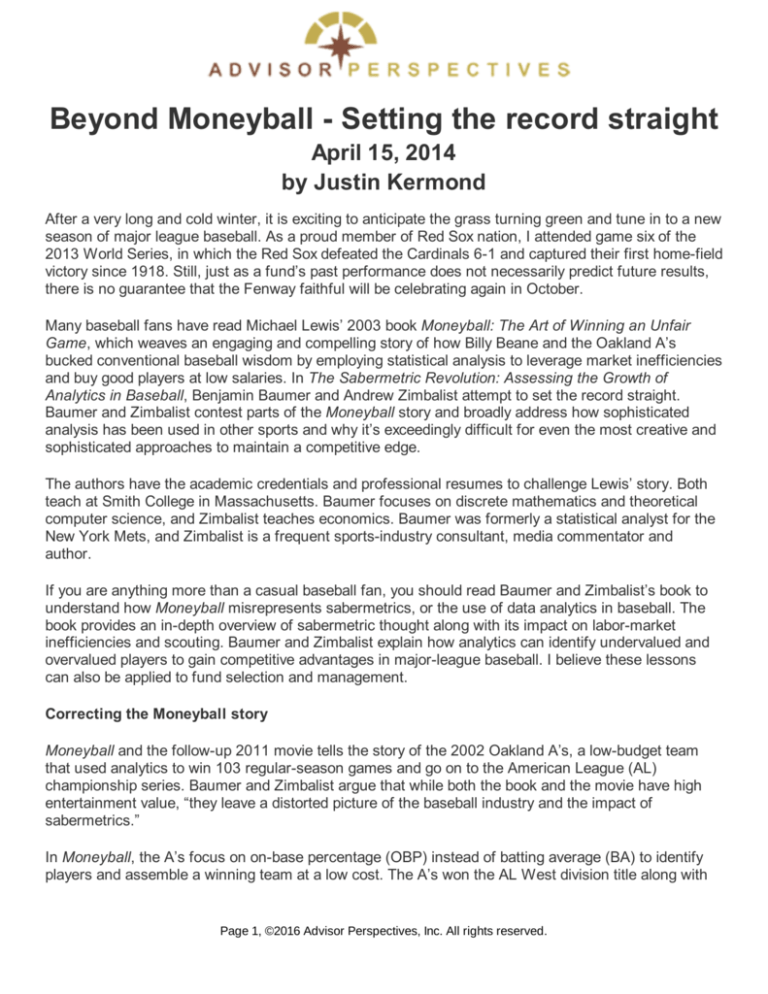
Beyond Moneyball - Setting the record straight
April 15, 2014
by Justin Kermond
After a very long and cold winter, it is exciting to anticipate the grass turning green and tune in to a new
season of major league baseball. As a proud member of Red Sox nation, I attended game six of the
2013 World Series, in which the Red Sox defeated the Cardinals 6-1 and captured their first home-field
victory since 1918. Still, just as a fund’s past performance does not necessarily predict future results,
there is no guarantee that the Fenway faithful will be celebrating again in October.
Many baseball fans have read Michael Lewis’ 2003 book Moneyball: The Art of Winning an Unfair
Game, which weaves an engaging and compelling story of how Billy Beane and the Oakland A’s
bucked conventional baseball wisdom by employing statistical analysis to leverage market inefficiencies
and buy good players at low salaries. In The Sabermetric Revolution: Assessing the Growth of
Analytics in Baseball, Benjamin Baumer and Andrew Zimbalist attempt to set the record straight.
Baumer and Zimbalist contest parts of the Moneyball story and broadly address how sophisticated
analysis has been used in other sports and why it’s exceedingly difficult for even the most creative and
sophisticated approaches to maintain a competitive edge.
The authors have the academic credentials and professional resumes to challenge Lewis’ story. Both
teach at Smith College in Massachusetts. Baumer focuses on discrete mathematics and theoretical
computer science, and Zimbalist teaches economics. Baumer was formerly a statistical analyst for the
New York Mets, and Zimbalist is a frequent sports-industry consultant, media commentator and
author.
If you are anything more than a casual baseball fan, you should read Baumer and Zimbalist’s book to
understand how Moneyball misrepresents sabermetrics, or the use of data analytics in baseball. The
book provides an in-depth overview of sabermetric thought along with its impact on labor-market
inefficiencies and scouting. Baumer and Zimbalist explain how analytics can identify undervalued and
overvalued players to gain competitive advantages in major-league baseball. I believe these lessons
can also be applied to fund selection and management.
Correcting the Moneyball story
Moneyball and the follow-up 2011 movie tells the story of the 2002 Oakland A’s, a low-budget team
that used analytics to win 103 regular-season games and go on to the American League (AL)
championship series. Baumer and Zimbalist argue that while both the book and the movie have high
entertainment value, “they leave a distorted picture of the baseball industry and the impact of
sabermetrics.”
In Moneyball, the A’s focus on on-base percentage (OBP) instead of batting average (BA) to identify
players and assemble a winning team at a low cost. The A’s won the AL West division title along with
Page 1, ©2016 Advisor Perspectives, Inc. All rights reserved.
an AL record of 20 straight wins.
Zimbalist and Baumer offer a number of corrections to the Moneyball story:
The character of Peter Brand, the short, heavyset and dorky Yale graduate analyst hired by
Beane is actually based on tall, thin Harvard graduate Paul DePodesta. DePodesta, having
reviewed the screenplay, refused to give permission for the film to use his real name.
Jeremy Giambi was not acquired during the 2001-02 offseason due to his high OBP. He was
acquired by trade prior to the 2000 season.
The movie showed that substituting the high-OBP Scott Hatteberg for Rookie of the Year
candidate Tony Pena was a key element of the team’s success after May 23, 2002. However,
Pena was not traded away in May with Giambi. He remained on the A’s until July.
No general manager on a very low budget would spend the money to fly to Cleveland to discuss
trades around a relief pitcher, as was depicted in the movie. This artistic license was a way to
introduce the character of Peter Brand.
The film omitted Sandy Alderson, a key Oakland executive, and gave full credit to Beane for
introducing sabermetrics to the A’s. In fact, Alderson introduced sabermetrics to the A’s in the
1980s and to Beane in the 1990s. There is a long history of the development and application of
sabermetrics that was omitted from the movie and minimally included in the book.
The movie’s deep divide between the analysts (Brand and Beane) and the traditional scouts is
highly exaggerated, according to Paul DePodesta.
Baumer and Zimbalist assert that “if Beane were a true student of sabermetrics,” he would have
never said to manager Art Howe, “I don’t care about righty/lefty.” There is sabermetric evidence
going back to the 1950s that facing a pitcher of the opposite hand improves hitting success.
The book quotes Beane telling his players to stop stealing bases, but this would have been a
“bastardization of the sabermetric wisdom” and Baumer and Zimbalist conclude that the “notion
that a saber-savvy GM would outlaw base stealing is, at best, misguided.”
Beane did not meet Red Sox owner John Henry in Fenway Park, but instead at Henry’s home in
Boca Raton. Furthermore, Beane actually did accept Henry’s offer for the Red Sox General
Manager position the day after the meeting, but then later reneged.
The authors do an impressive job of outlining what aspects of the A’s success were attributable to
sabermetrics and what aspects were not. The authors provide a full 22 pages of details regarding the
inconsistencies of Lewis’ account of the 2002 Oakland A’s success and Lewis’ oversimplification of
sabermetric principles, history and application.
For example, Lewis focused on submariner pitcher Chad Bradford, whose actual contributions to the
team were minimal despite positive sabermetric statistics. Baumer and Zimbalist, in contrast, attribute
the A’s pitching success to Barry Zito, Tim Hudson and Mark Mulder, three of the top 10 pitchers in the
American League. Baumer and Zimbalist attribute the hitting and fielding success of the A’s to 2002
AL MVP Miguel Tejada and third baseman Eric Chavez, both of whom Lewis barely acknowledged in
his story.
Had Lewis been called to defend his story in a debate with the authors, I believe the tone would harken
back to the style and content of a Buckley/Galbraith debate where both sides are highly articulate and
Page 2, ©2016 Advisor Perspectives, Inc. All rights reserved.
factual with an undertone of respect and restrained amusement.
Current sabermetric theory
The authors shed light on how baseball management, also called the “front office,” combine statistical
analysis with traditional analysis and discuss the growth and application of baseball analytics since
2002. Currently all but four major league teams have front-office staff working in analytics, and 17
teams have at least two full-time staff primarily focused on analytics. The 2008 Tampa Bay Rays went
as far as the World Series with a $43 million payroll, the second-lowest in major-league baseball. The
Rays currently employ eight people in their analytics department, including “three systems developers,
two baseball operations assistants and two junior analysts working under director of baseball research
and development James Click.”
In parallel with these staffing changes, more and better data are flowing to these front-office
employees. As a result, teams are upgrading technological infrastructure and some are outsourcing
analytic tasks to third-party vendors. The authors argue that the greatest challenge to clubs and
potentially “the source of the next market inefficiency” is to find talented employees capable of deriving
meaningful information from this “torrent of data.”
The details of sabermetric theory are short in the Moneyball book and nonexistent in the movie.
Baumer and Zimbalist fill this void with two full chapters containing comprehensive explanations of
sabermetrics theory. They explain why teams win games by presenting Bill James’ Pythagoreanexpectation statistical model that relates a team’s runs scored and runs allowed to its expected winning
percentage. They provide a comprehensive overview of offensive and defensive sabermetric thought.
On the offensive side, the authors take a deep dive into sabermetric thought on base running, hitting
and predictive analysis. Although the authors concede that the defensive components are more elusive
to sabermetricians than the offensive components, they outline the current sabermetric theories as
applied to pitching, fielding, wins above replacement, platoon effects, clutch hitting, the “hot hand” and
sacrifice bunting.
Analytics in other professional sports
The authors note that sabermetrics started as a hobby, with “a growing group of intellectually curious
stat heads” in the 1970s “trying to parse the myths and mysteries of the game.” It was not until the
1990s that the hobby of sabermetrics became the vocation of sabermetrics thanks to early adopters
such as Sandy Alderson, Larry Lucchino and Dan Duquette.
In its hobbyist stage, sabermetrics grew in the public domain ‑ its growing body of information was
accessible to all. As sabermetrics was adopted by the front offices in baseball, the application of
sabermetric theory became more proprietary, with each front office trying to best other teams. In other
sports, such as football and basketball, the development of sports analytics has been purely for
commercial interests and is thus fragmented.
The authors wrote that there are “greater statistical conundrums” applying analytics to other sports
Page 3, ©2016 Advisor Perspectives, Inc. All rights reserved.
outside of baseball. Baseball lends itself to quantitative analysis to distinguish player performance. It is
easier to isolate an individual player’s productivity and success. A baseball batter’s success “depends
directly on the actions of only one or two opposing players, and each play has a limited number of
outcomes,” according to Baumer and Zimbalist. In contrast, measuring individual performance is more
difficult in hockey, basketball, soccer and football.
The authors provide a detailed overview of basketball analytics and conclude there is little evidence to
show that teams that adopt analytics fare better. They do note that the Boston Celtics’ acquisition of
Kevin Garnett was a direct result of the statistical insight that most NBA recent champions had three
all-star players, one of whom was a league MVP or Top Fifty all-time player. In their discussion of
football analytics, Baumer and Zimbalist note that “with the possible exception of the New England
Patriots, there appears to be little correlation between the adoption of analytics and playing field
success.” The Patriots preceded the A’s in integrating front-office analytics with on-field coaching.
Conclusion
Baumer and Zimbalist conclude that sabermetrics can add value in quantifying the value of players and
their skills. They feel that the cutting edge sabermetricians are focused on defense along with
integrating video analysis with statistical analysis. Thus the sabermetricians are adopting the visual
analytical skills used by traditional scouting methodologies. Similarly, scouting staffs are assimilating
many sabermetric tools in their evaluation of player talent.
Thus a new multidimensional paradigm for player evaluation is evolving. Furthermore, as “market
inefficiencies disappear and the search for new ones continues, what really distinguished one MLB
front office from another is intelligence,” as “intelligent executives are more likely to explore new
terrain” that gives them an advantage over their competition.
The notion that market inefficiencies are exceedingly difficult to identify and exploit – and disappear
quickly – is familiar territory for market participants. Building a world-championship sports franchise
becomes more difficult every year, as each team improves its analytical capabilities. So, too, is the task
of picking a stock or mutual fund that will outperform.
Justin Kermond is the vice president of business development for Advisor Perspectives.
Page 4, ©2016 Advisor Perspectives, Inc. All rights reserved.








